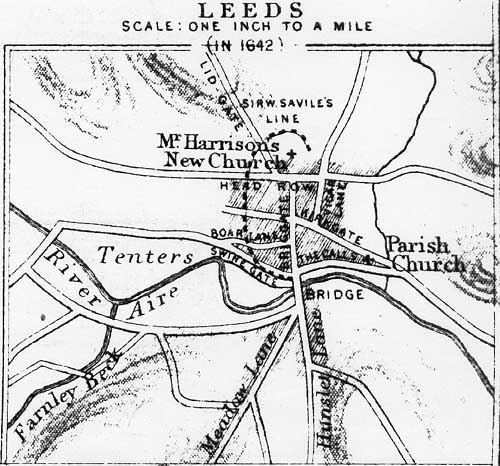3,000 2,000 Result Parliamentarian Victory | Date 23 January 1643 Combatants Cavalier, Roundhead | |
 | ||
Similar Relief of Montgomery Castle, Battle of Olney Bridge, Battle of Camp Hill, Battle of Aylesbury, Sieges of Taunton | ||
The Battle of Leeds was a battle in the English Civil War on 23 January 1643.
Contents
Background
The small wool town of Leeds in the West Riding of Yorkshire, in what is now West Yorkshire, was of no real strategic importance in the English Civil War. It comprised a triangle formed of the lines of the present lower Briggate, Kirkgate, and the River Aire, with Kirkgate leading to the parish church close or on site of the modern one. The streets were narrow and unpaved, lined with houses made of wood and thatch, rather than stone and tiles. Around the town lay open fields and meadows. The main street through the town, Briggate, was a wide street that ran north from the bridge over the River Aire, with narrow houses either side and a courthouse, or Moot Hall, in its centre near the junction with what is now Vicar Lane.
Prelude
At first the West Riding of Yorkshire constituted one wide area for the Parliamentarians with Leeds, Bradford and Halifax equally zealous in furnishing men and money for the cause. The conflict, however, opened badly for Parliament. In December 1642, the Marquess of Newcastle drove Sir Thomas Fairfax and his father, Ferdinando, Lord Fairfax, the leaders of the Yorkshire Roundheads, from Tadcaster to Selby; then, occupying Pontefract, he cut off the towns in the West Riding from re-inforcements. At the beginning of 1643, from his base in Bradford, Sir Thomas Fairfax launched a fresh campaign against Newcastle's forces.
The Royalist Sir William Savile had seized Leeds and Wakefield, although his forces comprised barely 500 horse and 1,500 infantry. He did, however, make elaborate preparations for the town's' defence, digging a long six-foot deep trench to the west of Briggate from St. John's Church on what is now New Briggate to the banks of the river, with breastworks along its top, while demi-culverin cannons were placed in such a position to sweep Briggate with fire. Leeds Bridge was barricaded and fortified with cannon. Fairfax had assembled men from Bradford, Halifax and the surrounding area totalling nine troops of cavalry and dragoons, 1,000 musketeers and 2,000 clubmen.
Finding the bridge at Kirkstall had been destroyed by the Royalists to disrupt the approach to Leeds, Fairfax crossed the Aire at Apperley Bridge, and came on to Woodhouse Moor, the site of the modern day University of Leeds, from where he sent a trumpeter to Saville requiring him, in writing, to give up the town to the Parliamentarians. Savile refused both the first and second requests to surrender.
Battle
At around 1pm or 2pm, and in the teeth of a heavy snowstorm, Fairfax led his troops forward to assault the Royalist fortifications. Five companies of the Parliamentarian forces marched on St John's Church, led by Fairfax and Sir Thomas Norcliffe, while Sergeant-Major forbes attacked the breast-works close to Boar Lane.
Soon after, a dragoon detachment under Captain Mildmay comprising thirty musketeers and one thousand clubmen, attacked Leeds Bridge from the south.
The Royalists, assaulted at three points, were broken and driven down Kirkgate to their defences near the Parish Church. From the church they attempted to escape across the river, though several were drowned.
The battle lasted over three hours and the victorious Parliamentarians took 500 prisoners, four colours, two brass cannon and arms and ammunition. In all about 40 men were killed of whom 12 were on the Parliamentarian side. The prisoners were required to swear an oath not to take any further part in the conflict and were released.
Aftermath
Soon after this defeat the Royalists fell back to the city of York and Sir Thomas recaptured Wakefield. This was, however, almost immediately followed by another Royalist advance into the West Riding, this time under Newcastle himself. The Battle of Adwalton Moor saw the Parliamentarians narrowly defeated by Newcastle’s forces, with Bradford falling shortly afterwards. Fairfax escaped and spent the rest of 1643 besieged in the Parliamentarian stronghold of Hull.
The Royalists only withdrew to York when the Scottish Covenanter army marched south in support of Parliament. In July 1644, the Royalists were comprehensively defeated at the Battle of Marston Moor, which lost the north of England for King Charles I.
